AREA AROUND MT FUJI
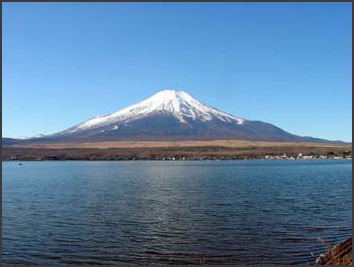
Mt. Fuji and the Five Lakes can be reached in two hours from Shinjuku in Tokyo. Mt. Fuji is Japan's highest mountain at 3,776 meters (12,388 feet) and is one of Japan's most iconic sights. Around its broad base are many lakes, waterfalls, virgin forests, ice caves and various alpine plants. The region is an ideal recreation area year-round.
Three prefectures surround Mt. Fuji — Kanazawa, Shizuoka and Yamanashi — and the all have numerous views of the mountain. The premier tourist areas are Hakone in Kanagawa, Izu in Shizuoka and the five lakes of Yamanashi. All of these places are close enough to Tokyo to attract weekend crowds.
Many of these areas are part of Fujisan, sacred place and source of artistic inspiration, which was designated a UNESCO World Heritage Site in 2013. According to UNESCO: Various parts of the property have been officially designated as an Important Cultural Property, a Special Place of Scenic Beauty, a Special Natural Monument, a Historic Site, a Place of Scenic Beauty, and a Natural Monument, in addition to it being designated as a National Park. The overall landscape of the summit is protected as part of the Fuji-Hakone-Izu National Park and this includes the lava tree molds and Lakes Yamanakako and Lake Kawaguchiko. Most component sites, including the ascending routes, shrines and lakes within the summit, have been given national protection as important cultural properties, historic sites or places of scenic beauty – within the last two years. The Murayama and Fuji Sengen-jinja Shrines and the Oshino Hakkai springs were protected in September 2012. [Source: UNESCO]
The extensive base of Mt. Fuji is strewn with lakes, waterfalls, ice caves, virgin forest and almost 2,000 kinds of alpine plants which change according to the altitude. In addition to hiking, visitors can partake in a number of recreation activities such as swimming, fishing and camping in the summer, and skating and skiing in the winter.
Around the base are 2,000 registered religious organizations, including the remnant of the Aum Supreme cult, and 117 golf courses, each boasting a view of the sacred mountain. There is also a safari park, amusement park rides and roller coasters. A couple of years ago a company made plans to construct a cable car to the summit that would replace the nine-hour ascent with a 40-minute ride but hikers were so vocal in their outrage the plans were scrapped. A 34-square-mile area on Mt. Fuji s eastern flank is used by the Japanese and American militaries for live fire exercises.
Fuji's Five Lakes
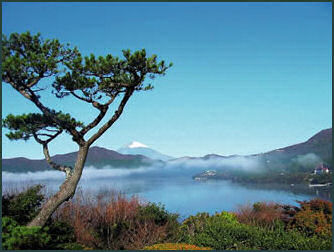
Fuji's Five Lakes (northern side of Mt. Fuji) include 1) Lake Kawaguchi-ko (2 hours and 10 minutes from Tokyo), which is noted for its majestic view of Mt. Fuji on its northern shore and its many museums; 2) Lake Yamanaka (35 minutes by bus from Gotemba or Kawaguchiko), the largest of the five lakes; 3) Lake Saiko (25 minutes by bus from Kawaguchiko), the smallest of the lakes; 4) Lake Saiko, said to be the prettiest of the lakes; and 5) Lake Motusa, renowned for the beauty of its deep blue water and the fact it seldom freezes because of its 450-foot depth.
According to UNESCO: The Fuji Five Lakes (Fujigoko), and especially the two larger lakes – Lake Yamanakako and Lake Kawaguchiko, face increasing pressure from tourism and development, and the springs and ponds also face threats from low-rise development. [Source: UNESCO]
The town of Kawaguchi-ko on the lake of the same name is popular take off point for hikes of Mt. Fuji. Nearby is Sengen-jinja Shrine, where pilgrims used to stop before making the descent, and the Fuji Highland amusement park. Lake Saik-ko is less developed than the other lakes. Here there are good views of the Mt. Fuji and access to the Narusawa Ice cave and Fugaku Wind Cave, both formed by lava flows in ancient eruptions. Websites: Japan Guide japan-guide.com ; JNTO PDF file JNTO ;Mt. Fuji Five Lakes Area mt-fuji.gr.jp ; Yamanashi Tourist Information yamanashi-kankou.jp
Views of Mt. Fuji
Koichi Saijo wrote in the Yomiuri Shimbun: “From Mishima Station, I took local lines to JR Fujinomiya Station, where I rented a car for a tour of the city’s sights around the base of Mt. Fuji. My first stop was Shiraito no Taki (waterfall of white threads), which is 20 meters tall, 150 meters wide and backed by a slightly curved, sheer cliff. Natural springs from Mt. Fuji seep out from the cliff here and there to create a stunning curtain of water. [Source: Koichi Saijo, Yomiuri Shimbun, February 2, 2017]
“One thing any visitor to the area around Mt. Fuji wants to see is no doubt an “upside-down Fuji,” or the mountain reflected in a body of water. The mountain’s Yamanashi Prefecture side has several well-known spots for taking photographs of this spectacle, such as Lake Yamanaka. However, I was told that the west side of Lake Tanuki in Fujinomiya also makes for good photos, so I stopped by early the next morning on my drive to the Asagiri Kogen highlands. There is usually little wind in the morning, which makes for better pictures.
“Standing on a viewing deck near the Kyukamura Fuji accommodation facility, there was a little wind but not enough to make waves. For my first upside-down Fuji, it was more than enough to move me. A phenomenon known as “Diamond Fuji” can be seen here when the sun rises right behind Mt. Fuji in the mornings around April 20 and August 20 every year. If you catch the mountain reflected in the water, you can glimpse the rare “Double Diamond Fuji.”“
Hot Springs with a View of Mt. Fuji
Fujiyama Onsen 10:00 am-11:00 pm, (enter by 10:00 pm) , Open daily except several days a year for a, maintenance (October17, November7, December12 in 2019 and, January 9, 16, 21, February 6, 13 in 2020) , Weekdays: 1,500 JPY, Saturday, Sunday and national holidays:, 1,800 JPY, Admission includes rental towels., (a bath towel and a face towel). Getting There: 4-17-1 Shin-Nishihara, Fujiyoshida-shi,, Yamanashi Pref., 4-17-1, 0555-22-1126, Free shuttle bus service is available between, Fujisan-eki Station or Kawaguchiko Station and Fujiyama, Onsen., Website: fujiyamaonsen.jp
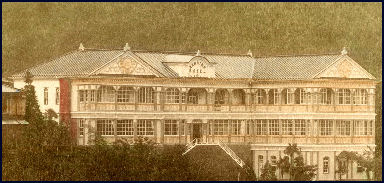
Naraya Hotel in the 19th century Fuji Chobo no Yu,‘Yurari’ 10:00 am-10:00 pm, (enter by 9:00 pm) , Open daily except several days in the beginning of, June for a maintenance, Weekdays:, 1,300 JPY (10:00 am-7:00 pm) , 1,100 JPY (7:00 pm-10:00 pm) , Saturday, Sunday and national holidays:, 1,500 JPY (10:00 am-7:00 pm) , 1,300 JPY (7:00 pm-10:00 pm) , Admission includes rental towels., (a bath towel and a face towel); Getting There: 8532-5 Narusawa-mura,, Minamitsuru-gun, Yamanashi Pref., 8532-5, 0555-85-3126, (1) 20 min. by bus bound for Motosuko from, Kawaguchiko Station to Fuji-Midori-no-Kyukamuramae Bus Stop., (2) Free shuttle bus service is available between, Kawaguchiko Station and Yurari., Reservation is required by phone up to 1hour, before boarding., Website: fuji-yurari.jp
Hotel Mifujien 1:00 pm-9:00 pm, (enter by 8:00 pm) , Open daily except several days a year for a, maintenance, 1,200 JPY, Admission includes rental towels., (a bath towel and a face towel); Getting There: 207 Azagawa, Fujikawaguchiko-machi,, Minamitsuru-gun, Yamanashi Pref., 207, 0555-72-1044, 15-20 min. by “Sightseeing Bus (red line) ” from, Kawaguchiko Station to Azagawa-Onsen-gai Bus, Stop., Website: mifujien.co.jp
Hotel Mt. Fuji, Mantenboshi no Yu 2:00 pm-6:00 pm, Hanare no Yu, 12:00 pm-4:00 pm (Wednesday 2:00 pm-6:00 pm) , Open daily except several days a year for a, maintenance (December9-12 in 2019) , 1,700 JPY, Admission includes rental towels., (a bath towel and a face towel); Getting There: 1360-83 Yamanaka,, Yamanakako-mura, Minamitsuru-gun,, Yamanashi Pref., 1360-83, 0555-62-2111, About 30 min. by bus from Fujisan-eki Station to, Fujisan Yamanakako (Hotel Mt. Fuji Iriguchi) Bus, Stop, and then 10 min. by free shuttle bus., Please call when you arrive at the bus stop., Website: mtfujihotel.com
Yamanakako Onsen, Benifuji no Yu 10:00 am-9:00 pm, (enter by 8:30 pm) , Saturday, Sunday and national holidays, from December to February:, 6:00 am-9:00 pm, (enter by 8:30 pm) , Closed on Tue., but open daily from July to September,, on national holidays and year-end and new year, holidays., 800 JPY, 150 JPY (a rental bath towel), 220 JPY (a face towel); Getting There: 865-776 Yamanaka,, Yamanakako-mura, Minamitsuru-gun,, Yamanashi Pref., 865-776, 0555-20-2700, 30 min. by “Fujikko-go Bus” from Fujisan-eki Station, to Benifuji-no-Yu Bus Stop. Website: benifuji.co.jp
Yamanashi Prefecture
Yamanashi Prefecture embraces the northern part of Mt. Fuji, the Five Lakes Area and Fuji-Q Highland. The prefecture covers 4,465.27 square kilometers (1,723 square miles), is home to about 835,000 people and has a population density of 187 people per square kilometer. Kofu is the capital and largest city, with about 190,000 people. It is in Chubu in central Honshu island and has five districts and 27 municipalities.
Fujikawaguchiko in Yamanashi Prefecture is famous for its vivid purple shibazakura flowers which bloom in May with Mt. Fuji in the background. About 800,000 shibazakura from seven varieties have been planted in a 2.4-hectare park.
Mount Minobu (Minobu-san, 3 hours by road, from Tokyo) is home to Kuonji Temple, the headquarters of the Buddhist Nichiren-shu sect. Kuonji offers you the chance to embrace traditional Japanese Buddhist customs — the aroma of incense, droning sutra chants and the calming rhythm of copying sutras by hand, are your gateways to an all-new experience. To really do it properly, book a stay at the nearby Gyogakuin Kakurinbo temple lodgings. Eat simple but nourishing shojin ryori — traditional vegetarian Buddhist fare — and live like a Japanese Buddhist monk and learn about the traditional Buddhist lifestyle while enjoying views of Mt. Fuji at Minobusan Kuonji Temple. Location: Minobu, Minobu-cho, Minamikoma-gun, Yamanashi. Website: kuonji.jp/english
Koshu Wine Region (100 kilometers west of Tokyo) is the primary wine-producing area of Japan. There are 80 or so wineries here, more than anywhere else in Japan. Hop in a locally-operated taxi and an English-speaking guide/interpreter will join you on a trip to some of Japan’s most prestigious wine producers, including the IWC award-winning Chateau Mercian. Tour the facilities, stroll through sweeping vineyards and — of course — sample sublime vintages together with mouthwatering appetizers. You’ll also visit a museum to learn all about the history of winemaking in Japan. Yamanashi is just two hours from Tokyo by train, making it an ideal day trip for any wine enthusiast! Location: 1-6-1 Marunouchi, Kofu-shi, Yamanashi; Website: veltra.com/en
Aokigahara Woods: Popular Hiking and Suicide Area
Aokigahara Woods (lower north slope of Mt. Fuji) is a popular hiking area in the summer and covered in snow in the winter. It has also been a popular suicide spot since the 1970s when a heroine in popular television drama based on the novel “Kawa-No-Oto” (1960), committed suicide there. The victims mostly die from drug overdoses and hangings.
In 1998, police found 73 bodies in the Aokigahara woods. The site is so popular that there are signs on the trails that read: "Wait a Minute! The world holds bitterness but also joy. You only have one life to live, so think it over."
Taxi drivers who work the nearest train station are told to be in the look out for possible suicide candidates, typically people who arrive and ask to be taken to the woods to go camping even though they don' have camping equipment or luggage. When an abandoned car is found, a search begins for the owners. Sometimes the body of the car isn't found but the bodies of other people are.
Fuji Q Highland Park
Fuji-Q Highland Park (near Mt. Fuji in Fujiyoshida) is a huge amusement park at the foot of Mt. Fuji. The park is known for having many intense thrilling rides and scream-inducing attractions. Challenge you fear of heights on the 50-meter tall swings or plunge from dizzying elevations on the vertical fall. While adults can try to find their way out of the Labyrinth of Fear children can amuse themselves in Thomas Land, entirely devoted to Thomas the Tank Engine and his friends.

Fuji area map
Fuji-Q Highland is the home of many roller coasters Among them are Do-Dodonpa- Fastest Roller Coaster, Takabisha-Steepest Roller Coaster. Eejanaika-4th Dimension Hypercoaster, Fujiyama-King of Coasters, High-profile thrill rides include Nagashimasuka-Shoot the Chute, Tentekomai-Sky Roller, Tekkotsubanchou-Sky Tower Swinger, Tondemina-Super Pendulum and rides inspired by Evangelion, GeGeGe-no-Kitaro, and Gundam.
Do-Dodonpa was once deemed the world’s fastest roller-coaster. Built at a cost of $25 million, it takes riders from 0 to 172kph in 1.8 second and drops them from a 52-meter spike, generating 4.25 G-forces, similar to those endured by astronauts at take off. A spokesman for the park said it is designed to "overload the senses." Fujikyu Highland Skating Center is world's largest multi-rink indoor skating rink: it has five rinks cover 285,243 square feet.
Location: 5-6-1 Shinnishihara, Fujiyoshida-shi, Yamanashi. Admission: One can buy individual tickets for the rides but the tickets for premier roller-coaster can cost over ¥2,000. A one-day pass is ¥ 6,200 for adults, ¥5,700 for junior and senior high school students: ¥4,500 for elementary school students; and ¥2,100 for, infants, seniors (65 years old and older), and pregnant women. There are special discounts and Priority Passes that allow to take rides without waiting. Hours Open: Fuji-Q Highland:10:00am-6:00pm; Thomas Land: 10:00am-5:00pm; La Ville de Gaspard et Lisa: 10:00am-6:00pm; Getting There: Fuji-Q Highland lies next to Fujikyu Highland Station on the Fujikyu Railway Line between Otsuki and Kawaguchiko Stations. The one way trip from Kawaguchiko Station takes two minutes and costs 180 yen. There are 2-3 departures per hour. Highway buses to the Fuji Five Lakes area generally stop at Fuji-Q Highland.These include direct buses to Shinjuku, Tokyo Station and Yokohama Station. Various combination tickets are available that include transportation and admission to the park. Additionally, many local buses and occasional Omni Buses on the Kawaguchiko Line stop at Fuji-Q Highland and Fujiyama Onsen. Website: Fuji Q fuji-q.com
Yamanashi Gem Museum
Yamanashi Gem Museum (in Fujikawaguchiko) opened in 1975 in Kofu, partly with the aim of vitalizing the jewelry industry. In 2007, the museum, which collects precious gemstones from all over the world, was relocated to its current spot, where it is visited by many tourists. The museum exhibits a total of 3,000 pieces, including raw stones, cut gemstones, jewelry items, sculpted handicrafts and various information resources.
Yasunori Kuroha wrote in The Japan News: “Yamanashi Prefecture has been known for its production of crystals for many years. In the final days of the Edo period (1603-1867), the processing of crystals began in earnest as an industry, and crystal mining peaked in the Meiji era (1868-1912) when mine development was liberalized. The processing industry for imported diamonds and other minerals is still thriving in the prefecture. [Source: Yasunori Kuroha, The Japan News, April 9, 2017]
“Drawing particular attention in the centre of the facility are three crystal clusters from Brazil. A crystal cluster is a group of crystals that were generated deep underground, grew over a long time and fused together. The three crystal clusters exhibited at the museum weigh from 149 kilograms to 273 kilograms each. The transparent crystals are breathtakingly beautiful as they stand out against the reddish-brown pedestal.
“An amethyst geode, which grew in the hollow of a rock, is also remarkable. Purple amethysts fully cover the rock surface, which looks like a work of art. Visitors are also drawn to a giant single crystal, displayed next to the geode, that is 1.8 meters tall and weighs 1.27 tons. Photo: The Japan News/ Asia News Network "Human technology is applied to the mystery of nature to create jewelry," said Hotaru Natsume, a 28-year-old woman who visited the museum from Yokohama with her husband.
”There are also panels to help visitors learn about gemstones, explaining for example the origin of the word diamond and its history, and introducing the fact that crimson rubies and deep-blue sapphires are the same mineral. The museum has a shop with affordable souvenirs such as key chains and bracelets, as well as authentic jewelry, and a cafe offering tea, cakes and other items. Location: 6713 Funatsu, Fujikawaguchiko, Yamanashi Prefecture; Hours Open: 9:00am to 5:30pm from March to October. 9:30am to 5:00pm from November to February. Closed on Wednesdays. Open every day in July and August. Admission: ¥600 (S$7) for high school students and older, and ¥300 for elementary and junior high school students. Admission is free for the shop and cafe.
Hakone
Hakone (1½ hours by Shinkansen from Tokyo) is a highly-developed tourist area famous for its spas, 17 hot water springs, 250 hot spring inns and beautiful mountains. Wedged between Mt. Fuji and the Izu Peninsula, Hakone covers a fairly large area with forested mountains and deep ravines. Among those that have came here to reinvigorate themselves were Toyotomi Hideyoshi and John Lennon.

another hotel in the 19th century Located on a major Edo period crossroads, Hakone welcomes 18 million visitors a year. Hakone is situated in the beautiful mountains which comprise the Fuji-Hakone-Izu National Park. On fine days magnificent views of Mt. Fuji are possible. The stylish Romance Car express train will take you from Tokyo’s Shinjuku Station to Hakone in only 75 minutes. Keep in mind though the Hakone area is very geologically active. In 2015, the hot-spring district rose by up to 15 centimeters in two weeks as sulfurous steam gushes from vents in the mountain’s flank. There were worries about earthquakes, even a volcanic eruption.
Hakone is a perfect day trip destination from Tokyo, or spend the night in one of the luxurious Michelin-starred ryokan resorts or hotels.A number of special tickets and package deals are available, You can check them out at the Odakyu Sightseeing Service Center at Shinjuku Station in Tokyo, where you catch the train for Hakone. The three-day Hakone Freepass, which costs ¥5,500 for adults and ¥2,750 for children, includes passage on eight different types of transportation and discount tickets for 55 designated facilities, including the museums and sights mentioned above. For information call the Fuji-Hakine-Izu International Tourism Association at Tel: (054)-221-2858.
Websites:Hakone Navi hakonenavi.jp ; ; Kanagawa Prefecture site kanagawa-kankou.or.jp ; Wikipedia Wikipedia ; Wikitravel Wikitravel Map: Hakone Navi hakonenavi.jp Hotel Websites: Kanagawa Prefecture site kanagawa-kankou.or.jp ; JapanHotel.net JapanHotel.net Ryokan and Minshuku Hakone Navi hakonenavi.jp ; Japanese Guest Houses Japanese Guest Houses Budget Accommodation: Japan Youth Hostels Japan Youth Hostels Check Lonely Planet books Getting There: Hakone is one hour and ten minutes from Tokyo by limited express train and one hour and 45 minutes by regular train. Lonely Planet Lonely Planet
Hakone Towns
Hakone-Yumoto (40 miles southwest of Tokyo) is the main gateway to the Hakone Spa area. Located on the confluence of the Hayakawa River and Sukomo River, it is touristy hot spring resort with many inns beautifully located along the gorge. Miyanoshita (near Hakone-Yumoto) is the main town in the area with its many spas. It is also a good starting point for trips to Lake Ashi, Gora Spa and the Sengokuhara Plain. Kawaguchi is an onsen resort town with beautiful views of Mt, Fuji across Lake Kawaguchi.
Fujiyoshida is regarded as one of the gateways to Mt. Fuji. It is the home of the Kitaguchi Hongu Fuji Sengen Shrine, and a starting place for people that want hike to top of Mt. Fuji all the way from the bottom of the mountain.
Fujiya (Miyanoshita) is a famous hotel with beautiful views of Mt. Fuji. Opened in 1878, it has welcomed kings and emperors and John Lennon and Yoko Ono as guests. There are special rates for foreigners, only $120 a room.
Gora (10 minutes by funicular railroad from Miyanoshita) is a spa town on a slope of the volcano Mt. Sounzan. A cable car leads to the top of Mt. Sounzan. On nearby Mount Myojo a huge bonfire is built in the shape of Chinese character during the Daimonjiyaki Festival. Gora Park is the largest rock park in the Orient. Its main features are a gigantic fountain pond, nature museum, alpine plant garden and wild tropical bird garden. The arched gate entrance to the park is decorated with roses and other flowers.
Hakone Museums
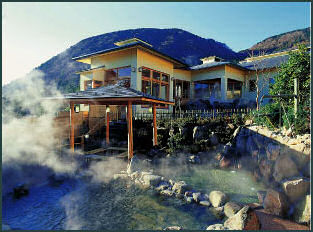
Hakone area onsen Hakone has a number of world-class museums nestled in its picturesque mountainscape. Among them are the Hakone Open Air Museum; the Narukawa Art Forum, with 40,000 works of art the Hakone Glass Forest Venetian Glass Museum, with Venetian glass from the 15th to the 18th centuries; the Museum of Saint-Exupery and the Little Prince; and the Pola Museum of Art.
The Lalique Museum contains 230 pieces jewelry and glass works by Rene Lalique, the master craftsman credited with launching the art nouveau and art deco movements in the 19th and 20th centuries. The museum also boats a pullman car from the famed Orient Express.
Hakone Museum of Art (Gora) is known for its superb display of old Japanese ceramics and sloping garden with 100 different kinds of moss. The Musée de Saint-Exupery et di Petit Prince recreates the life of the pioneer aviator and the author of the “Little Prince” in the atmosphere of a French village. Sometimes there is even a genuine Frenchman who walks around dressed up as Saint-Exupery.
Okada Museum of Art specializes East Asian, with ancient and modern works exhibited in perfect harmony with nature Opened in 2013, the museum boasts more than 5,000 square meter of exhibition space in a five-floor building that blends seamlessly into the surrounding forests. The regular exhibition features 450 works from Japan, China, and Korea, including paintings, ceramics, and religious art from ancient to modern times. Once you’ve seen everything, visit the footbath café to enjoy a drink and relaxing soak while beholding a majestic mural of Japanese wind and thunder gods, then take a stroll through the exquisitely maintained Japanese garden. Location: 493-1 Kowakudani, Hakone-machi, Ashigarashimo-gun, Kanagawa. Website: trip.pref.kanagawa.jp ; okada-museum.com
Hakone Open Air Museum
Hakone Open Air Museum (near Gora) is an awesome sculpture park. Founded in 1969 and situated among forests and mountains, it is a series of rolling lawns featuring works by Henry Moore, Isamu Noguchi, Barbara Hepworth, Rodin, Bourdelle, and Zadkine and sculptors. There is also an indoor museum with works by Picasso and others.
The outdoor museum covers 30,000 square meters. The works are equally divided among Western artist and Japan artists. Perhaps the most extraordinary thing about the museum is the way the sculptures are situated on grassy slopes, next to trees and with mountains in the background. Check out Hiroshi Nakamura Art under Natural Light.
The Open-Air Museum takes typical art viewing out of a building and puts it out under the open sky. It is filled with monumental art by modern to contemporary artists such as Rodin, Calder, Moore, Hepworth, Okamoto, Niki de Saint Phalle, and Vangi. Some of the collection, including Brancusi’s Kiss sculpture, Giacometti bronzes, and Picasso’s ceramics, are housed indoors. A small Picasso Museum is also on the grounds. Location: 1121 Ninotaira, Hakone-machi, Ashigarashimo-gun, Kanagawa 250-0493 +81-460-82-1161 Admission: According to UNESCO: fee is ¥1,600 (US$14.80) Website: Japan Guide japan-guide.com
Hakone Sights and Amusements
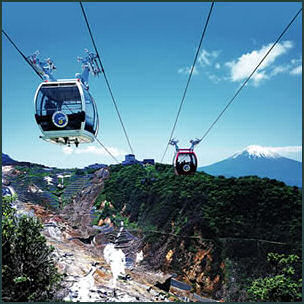
ropeway over Owakudani Other sights and activities include the Ancient Cedar Avenue, with 400 magnificent cedars planted early in the 17th century; the Ashinoko lake cruise; the Hakone Ropeway (the longest in Japan at 4,035 meters); the Hakone-Tozan Cable Car and the Hakone-Tozan railway.
Hakone-Tozan Railway (starting at Gora) is two-car train that climbs a mountain slope by repeatedly changing direction and going back and forth up a series of switchbacks. The ride is especially beautiful in late June and early July when 8,000 hydrangea plant along the route are in full bloom. Website: Japan Guide japan-guide.com
Kowakidani (Hakone-Tozan Railway and ropeway from Gora) is one of the most popular spa towns. Known in English as the Valley of Lesser Boiling, it has several sulfurous and bubbling hot springs. Much of the steam coming from the earth is utilized in warming greenhouses. In April, the entire spa is awash in cherry blossoms and azalea blooms.
Owakudani (Hakone-Tozan Railway and ropeway from Gora) is located in the crater of volcano Mt. Kamiyama. Known in English as Valley of Greater Boiling, it reeks of sulfur and is covered in clouds of steam rising from crevasses and bubbling hot springs. The Natural Science Museum here has displays of local flora and fauna and information about climatic and geological features of the Hakone hot spring area. Website: Japan Guide japan-guide.com
Other sights to the north of Mt. Fuji include Narusawa Ice Cave, a lava-formed cave that has ice in it even in the summer; Saiki Iyashi no Sato Nembsa, a restored of village thatch-roof houses; and Hananomiyako Koen Park, a popular place to see a variety of flowers.
Lake Ashi
Lake Ashi (2,400 feet above sea level) is the principal attraction of Hakone. It has a circumference of 11 miles and abounds with bass and trout. It is also known for its inverted reflection of Mt. Fuji. Boats link the resort towns around the lake. A motorized tourist boat that looks like a pirate ship cruises the lake and offers nice views of Mt. Fuji. Website: Japan Guide japan-guide.com
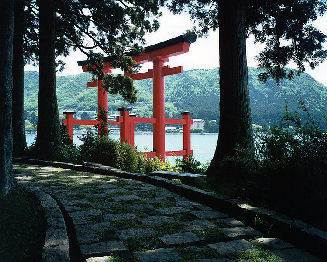
Mote Hakone is the main center for pleasure boating on the lake. Within a 15 minute walk is the famous Hakone Shrine. Founded in the 8th century and located on the shores of the lake, it has a red torii gate built in 1667. Mote Hakone is also where you can find Cryptomeria Avenue a two-kilometer-long path lined with 370-year-old cedar trees. From Mote Hakone you can walk for 3½ hours on the a section of the Old Tokaido Highway, which connected Kyoto with Edo, to Hakone-Yumoto Station.
Hakone-Machi is another resort town and boating center. Nearby stands a replica of the Old Hakone Check Point, an indication that Hakone was an important rest stop for people traveling in Japan in the 17th and 18th century. The replica of the Check Point House contains life-size figures in traditional feudal costumes. Nearby is the Hakone Detached Palace Garden, a former villa with a lovely garden and displays of old weapons, armor, sedan chairs, old documents and everyday items from feudal Japan.
Open-air Hot Spring Baths in Hakone
Yumoto Fujiya Hotel-Soun Open daily 12 noon-8 pm, Admission: ¥1,800 (ages 13 and up), ¥1,000 (ages 6-12), ¥500 (ages 3-6) , Open-air baths: 2 for men, 2 for women Indoor baths: 1 for men, 1 for women; Getting There: Address: 256-1 Yumoto, Hakone-machi, Ashigarashimo-gun, Kanagawa Pref., Tel: 0460-85-6111 Access: 3 minute walk from Hakone-Yumoto Station, Website: yumotofujiya.jp
Yunosato Okada Open daily 11 am-11 pm (Enter by 10 pm) , Closed: Irregularly closed for maintenance, Admission: Monday-Sunday ¥1,400 (ages 13 and up), ¥600 (ages 3-12) , Open-air baths: 6 for men, 6 for women Indoor baths: 1 for men, 1 for women; Getting There: Address: 191 Yumoto-jaya, Hakone-machi, Ashigarashimo-gun, Kanagawa Pref., Tel: 0460-85-3955, Access: 5 min. by loop bus to"Hotel Okada" from Hakone-Yumoto Station (¥100) , Website: yunosato-y.jp
Hakone-no-yu Open Daily 10 am-10 pm (Enter by 9:30 pm) , Closed: Every three months for maintenance, Admission: ¥1,000 (ages 13 and up), ¥500 (ages 4-12) , Open-air baths: 4 for men, 4 for women Indoor baths: 1 for men, 1 for women; Getting There: Address: 100-1 Yumoto-jaya, Hakone-machi, Ashigarashimo-gun, Kanagawa Pref., Tel: 0460-85-8080, Access: 1 min. by loop bus to"Soun-dori" from Hakone-Yumoto Station (¥100) ,
Hakone Yuryo Mon-Fri 10 am-9 pm (Enter by 8 pm) , Saturday,Sunday, and National Holiday 10 am-10 pm (Enter by 9 pm) , Closed: Irregularly closed for maintenance, Admission: ¥1,300 (ages 13 and up), ¥650 (ages 4-12) , Complex facility (with relaxation service, restaurant, sauna etc) based on natural hot spring. Getting There: Address: 4 Tonosawa, Hakone-machi, Ashigarashimo-gun, Kanagawa Pref., Tel: 042-749-1230 (ODAKYU Resorts) , Access: 3 min. by free shuttle bus from Hakone-Yumoto Station,
Tenzan Tohji-kyo Open daily 9 am-11pm (Enter by 10 pm) , Closed: 5 days in mid-December for maintenance, Admission: ¥1,200 (ages 13 and up), ¥630 (ages 1-12) , Open-air baths: 5 for men, 6 for women; Getting There: Address: 208 Yumoto-jaya, Hakone-machi, Ashigarashimo-gun, Kanagawa Pref., Tel: 0460-86-4126, Access: 1) 10 min. by loop bus "B course, Soun-dori" from Hakone-Yumoto Station ¥100) , 2) 10 min. by Hakone Tozan Bus bound for Moto-Hakone via Hatajuku from, Hakone-Yumoto Station to Okuyumoto Iriguchi Bus Stop.
Image Sources: 1) 7) 17) JNTO 2) 3) 6) British Museum 4) 5) 14) Volcano Researach Center University of Tokyo 8) 12) Andrew Gray Photosensibility 9) Yamanashi Tourist Information 10) 13) Mount Fuji Guide 11) Climber.org 15) 19) 20) Kanagawa Tourist information 16) 18) Visualizing Culture, MIT Education 21) Wikipedia
Text Sources: JNTO (Japan National Tourist Organization), Japan.org, Japan News, Japan Times, Yomiuri Shimbun, UNESCO, Lonely Planet guides, New York Times, Washington Post, Los Angeles Times, National Geographic, The New Yorker, Bloomberg, Reuters, Associated Press, AFP, Compton's Encyclopedia and various books and other publications.
Updated in July 2020
